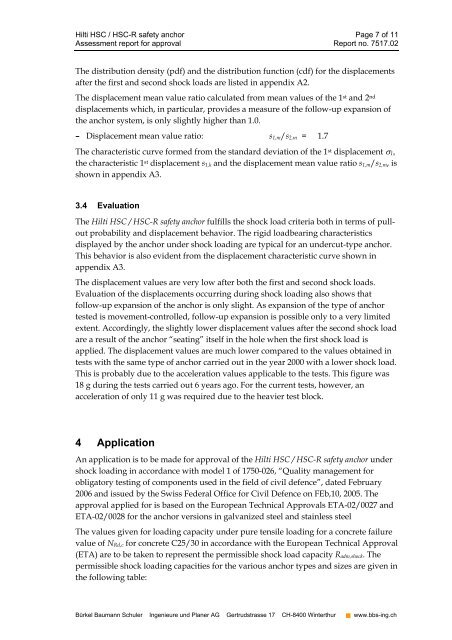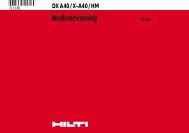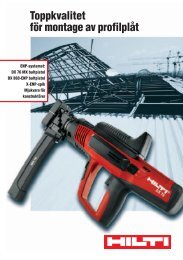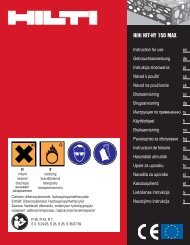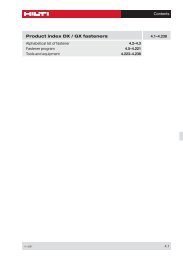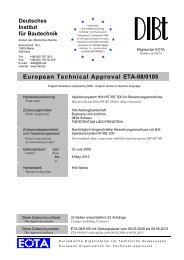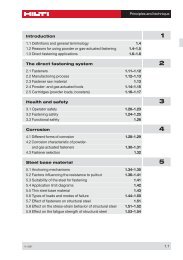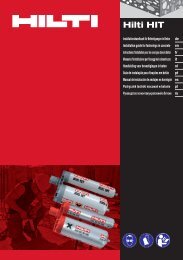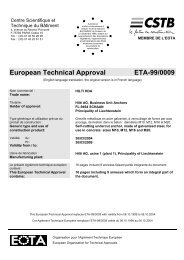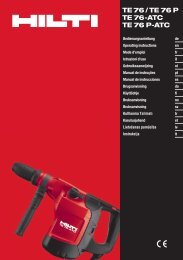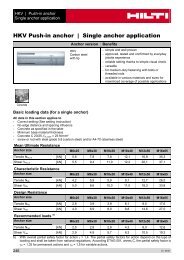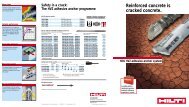Certificate of Approval
Certificate of Approval
Certificate of Approval
You also want an ePaper? Increase the reach of your titles
YUMPU automatically turns print PDFs into web optimized ePapers that Google loves.
Hilti HSC / HSC-R safety anchor Page 7 <strong>of</strong> 11<br />
Assessment report for approval Report no. 7517.02<br />
The distribution density (pdf) and the distribution function (cdf) for the displacements<br />
after the first and second shock loads are listed in appendix A2.<br />
The displacement mean value ratio calculated from mean values <strong>of</strong> the 1 st and 2 nd<br />
displacements which, in particular, provides a measure <strong>of</strong> the follow-up expansion <strong>of</strong><br />
the anchor system, is only slightly higher than 1.0.<br />
– Displacement mean value ratio: s1,m/s2,m = 1.7<br />
The characteristic curve formed from the standard deviation <strong>of</strong> the 1 st displacement σ1,<br />
the characteristic 1 st displacement s1,k and the displacement mean value ratio s1,m/s2,m, is<br />
shown in appendix A3.<br />
3.4 Evaluation<br />
The Hilti HSC / HSC-R safety anchor fulfills the shock load criteria both in terms <strong>of</strong> pullout<br />
probability and displacement behavior. The rigid loadbearing characteristics<br />
displayed by the anchor under shock loading are typical for an undercut-type anchor.<br />
This behavior is also evident from the displacement characteristic curve shown in<br />
appendix A3.<br />
The displacement values are very low after both the first and second shock loads.<br />
Evaluation <strong>of</strong> the displacements occurring during shock loading also shows that<br />
follow-up expansion <strong>of</strong> the anchor is only slight. As expansion <strong>of</strong> the type <strong>of</strong> anchor<br />
tested is movement-controlled, follow-up expansion is possible only to a very limited<br />
extent. Accordingly, the slightly lower displacement values after the second shock load<br />
are a result <strong>of</strong> the anchor “seating” itself in the hole when the first shock load is<br />
applied. The displacement values are much lower compared to the values obtained in<br />
tests with the same type <strong>of</strong> anchor carried out in the year 2000 with a lower shock load.<br />
This is probably due to the acceleration values applicable to the tests. This figure was<br />
18 g during the tests carried out 6 years ago. For the current tests, however, an<br />
acceleration <strong>of</strong> only 11 g was required due to the heavier test block.<br />
4 Application<br />
An application is to be made for approval <strong>of</strong> the Hilti HSC / HSC-R safety anchor under<br />
shock loading in accordance with model 1 <strong>of</strong> 1750-026, “Quality management for<br />
obligatory testing <strong>of</strong> components used in the field <strong>of</strong> civil defence”, dated February<br />
2006 and issued by the Swiss Federal Office for Civil Defence on FEb,10, 2005. The<br />
approval applied for is based on the European Technical <strong>Approval</strong>s ETA-02/0027 and<br />
ETA-02/0028 for the anchor versions in galvanized steel and stainless steel<br />
The values given for loading capacity under pure tensile loading for a concrete failure<br />
value <strong>of</strong> NRd,c for concrete C25/30 in accordance with the European Technical <strong>Approval</strong><br />
(ETA) are to be taken to represent the permissible shock load capacity Radm,shock. The<br />
permissible shock loading capacities for the various anchor types and sizes are given in<br />
the following table:<br />
Bürkel Baumann Schuler Ingenieure und Planer AG Gertrudstrasse 17 CH-8400 Winterthur � www.bbs-ing.ch


